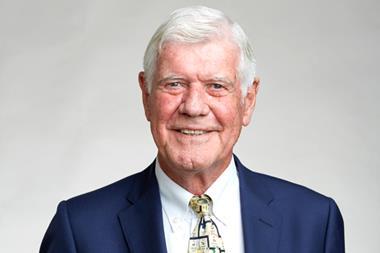Before the Braggs
From Peter Dryburgh
The article ‘Crystal clear’ caused me utter amazement. Statements that the science of crystallography was ‘completely new’ in the 20th century and that crystallography was invented by the Braggs require comment.
The subject effectively dates back to 1698, when Johann Höttinger introduced the concept of a crystal as a general type of body, as opposed to the previous use of the word which simply denoted quartz. Nicolaus Steno’s law of the constancy of interfacial angles, observed on quartz, was given general validity by the comprehensive measurements made by Jean Baptiste de L’isle following the invention of the contact goniometer by Arnould Carangeot in 1780. Both Robert Boyle and Robert Hook in the 17th century had discussed the packing of spheres in relation to macroscopic symmetry. The science of mineralogy has always been dominated by crystallography, with the foundations of the subject being based upon the use of the reflecting goniometer, the polarising microscope and the universal stage.
The enormous contribution made by the Braggs was the extension of crystallography down to the atomic level and the invention of modern diffraction techniques. The Braggs’ use of x-rays was brilliant work and is rightly celebrated for transforming the science of crystallography, but I do not believe that either of them would have claimed to have invented the subject.
Modern science education seems to propagate the unfortunate assumption that anything that happened more than 100 years ago is not worth bothering about.
P M Dryburgh FRSC
Edinburgh, UK
U and me
From Mark Foreman
While I am glad that an article has been published on actinide chemistry, I would like to point out two things.
Firstly, the article gives the impression that BTBP (bistriazinyl bipyridine) is a French invention, but it is in fact British. When I worked in Mike Hudson’s group at the University of Reading (2002–2006), the first sample of a BTBP was made as part of a quest to find a better americium extraction agent (partly to test the hypothesis that an americium extraction agent should have three nitrogens arranged in a similar way to terpyridine). The compound was supplied to a French radiochemist, Clement Hill, working at the the French Alternative Energies and Atomic Energy Commission who tested it and then promptly wrote to us asking for more of this wonder molecule.
Secondly, the article is dominated by uranium complexes that are unlikely to be found in either the nuclear fuel cycle or nature. I would like to point out that a lot of work is being done with relatively simple oxygen donors (such as isosaccharinic acid; ISA) that can form in a waste store with actinides such as thorium and americium. Dissolved organic matter has been shown to increase the mobility of plutonium in the ground water at the Nevada test site. ISA complexes to thorium and other actinides under alkaline conditions where these metals are normally expected to be immobile, which could affect a waste store by making the actinides more mobile. The actinide chemistry of ISA and other simple organics that could be found in a waste store are of great interest.
M Foreman MRSC
Chalmers University of Technology, Sweden
Nouns are -us
From John Boulton
David Snodin’s problem is simply a grammatical one. Phosphorus, the element, is a noun. Phosphorous is an adjective, with a plethora of meanings. Firstly, it simply means ‘containing or pertaining to phosphorus’. But inorganic chemists will know phosphorous acid (H3PO3), formally containing P(iii), and its oxidised (P(v)) counterpart phosphoric acid (H3PO4).
There is just the same dichotomy between ‘sulfurous’ and ‘sulfuric’, which does not lead to any confusion because the element sulfur does not end in ‘-us’.
John Boulton MRSC
Norwich, UK
Chilblain solution
From Alan Dronsfield
The recipe Paul Roebuck mentions in his letter, with the ingredients lead acetate and zinc sulfate, is indeed a lotion once used to treat chilblains. It has been taken, word for word, from The female’s friend and general domestic adviser by Robert Huish, published in 1837. This was an encyclopaedia that gave advice on items ranging from Aachen hams (the curing of) and abdominal ruptures and hernias (the management of) to, 822 pages later, Yorkshire puddings (the baking of).
The mixture will produce a precipitate of lead sulfate (hence its patent medicine name ‘white lotion’). Huish states ‘the lotion is to be well shaken; then rubbed into the parts affected before a good fire with the hand, for two or three minutes ... It scarcely ever fails curing the most inveterate chilblains by once or twice using.’
This lead–zinc-based lotion is still commercially available and is now recommended as a treatment for saddle sores on horses. But no longer, as far as I know, for chilblains.
A Dronsfield FRSC
Royal Society of Chemistry Historical Group
The devil you know
From Martin Ward
‘Chemists make good managers’ – so said an article in Chemistry in Britain about 20 years ago. Derek Lowe proposed the converse in his piece ‘Beelzebub Pharma Ltd’.
Lowe’s excellent demolition of current management principles struck too many chords with my working life (which started in 1966 and still staggers on, albeit part-time and, alas, not in chemistry) to raise anything but the grimmest of smiles.
By coincidence, Jeremy Lewis (author and columnist) was griping about much the same sort of thing, especially interminable meetings, in the publishing industry in the February edition of The Oldie.
The ‘professional manager’ has infected and infested both the private and the public sector and bamboozled everyone with his own brand of voodoo: the ability to make it look as though their practices are all about improving efficiency when they are, in fact, destroying it. I get the impression that small and medium sized enterprises are relatively free as they have to concentrate on real outputs; larger enterprises seem to relish them.
As Lowe implies, the effect of this managerialism on the morale of real workers trying to achieve real objectives can be devastating: Beelzebub, as I understand him, wants your soul intact – the professional manager drips acid onto it while insulting your intelligence.
Derek also mentions the importance of slogans for managers; Jeremy Lewis’ article is accompanied by a cartoon of a worker observing at a notice that says ‘To err is human, to forgive is not company policy’.
M Ward MRSC
Northampton, UK
Pain-free pioneer
From George Gamlen
Following the passing of Charles Suckling, which was reported in the February issue of RSC News, there must be many thousands of people all over the world who have cause to give thanks for his life and work.
Suckling’s invention of the volatile inhalational anaesthetic halothane (CF3CHBrCl; trademarked Fluothane) was a major step forward in replacing chloroform and diethyl ether in operational surgery.
He first synthesised halothane in 1951 and it had its first clinical trial in 1956, when its great advantage over the other anaesthetics was immediately recognised.
Not only was it a product that performed brilliantly, it is widely regarded as the one of the first examples of modern drug design in which a systematic study is made of compounds with predefined characteristics.
G Gamlen CChem FRSC
Altrincham, UK
Lazy gases
From Neil Dickinson
I see that the Mpemba effect – where hot water freezes faster than cold – has yet to be explained satisfactorily.
Reading about this reminds me of happy days working towards my PhD under the supervision of Eric Banks in the late 1970s. Much of my work involved the manipulation of gases (such as the beautiful blue gas trifluoronitrosomethane) that were often stored at slightly less than atmospheric pressure in large glass bulbs forming part of the vacuum apparatus.
On cooling deliberately constructed sections of the apparatus in liquid nitrogen, the gases would usually condense within a minute and the rate of condensation could be monitored by the rate at which mercury in a simple manometer would race upwards as the pressure dropped. What always baffled me was why the rate at which a gas condensed was much slower if the gas had been left untouched for say a week or more, than if it had more recently (within a day or two) been condensed and then allowed to evaporate, reach room temperature (always a constant 20°C) and therefore return to its original pressure as indicated on the manometer.
I observed this on numerous occasions and with different gases and referred to it in casual conversation with my labmates as the ‘lazy gas’ effect. Perhaps I was actually observing the opposite effect, where a recently condensed and then evaporated gas would re-condense more quickly than one which had stood neglected for a while. As the temperatures, pressures and volumes of the gases were essentially constant, as was the apparatus, I was at a loss to think of any straightforward reason for this observation. Can anyone explain it?
N Dickinson
Suffolk, UK
Stormy weather
From John Birtill
John Leisten reasonably complains about the failure by news media to distinguish between sciences. He less reasonably suggests that climatology is not a ‘hard science’ like chemistry, and is ‘sceptical’ about unspecified conclusions, presumably regarding climate change.
Global warming caused by increasing greenhouse gases is an inevitable consequence of the laws of physics and chemistry, including thermodynamics and quantum mechanics, and is mainstream textbook science. Sadly, many scientists have relatively little appreciation of the fundamental science. I was introduced to the complexity of modelling global warming by a paper in the proceedings of an American Chemical Society symposium in 1981.
However, the impact of global warming on the climate is obviously climatology. Ever since, I have followed with interest developments in the science of climate change and also the arguments made by so-called ‘deniers’ (generally rogues and cranks), and ‘climate sceptics’ (a vague, catch-all label that includes a very small minority of climatologists, who dispute some aspects of the science, and a larger number of other people, some of them motivated by political ideology).
Modelling the magnitude of global warming and the impact on the global climate is obviously a task of enormous scale and complexity, including ocean currents, atmospheric winds, clouds and ice over days, nights and seasons. The broad scientific consensus, which has been reached after many decades, is not due to a conspiracy by 97% of climatologists. It is the result of an immense amount of effort by many diligent and talented scientists.
Evidently, there is still much work to be done to improve the accuracy and precision of climate models, but we know enough already to realise that society will face immense challenges in the coming decades. Robust challenge to ‘climate scepticism’ is better than polite silence.
J J Birtill CSci CChem FRSC
Guisborough, UK
Chemistry World welcomes letters, which should be concise (normally fewer than 300 words) and timely. Those selected for publication are subject to editing for clarity and length. Letters should be marked ‘for publication’ and sent to chemistryworld@rsc.org. Letters are not routinely acknowledged.












No comments yet